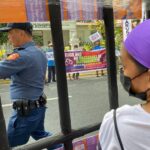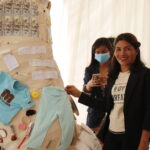; THE LONG MARCH: Where there is little hope for institutional redress, villagers affected by state and private projects resort to rituals and ceremonies as instruments of political resistance _ not very powerful tools for policy change perhaps, but at least they open up a public space that is their due in a democratic society
Mrs Son Darakhum is on the road again, this time on a Long March to demand that the government permanently opens the sluice gates of the Pak Moon and Rasisalai dams.
The Long March began with people who were directly affected by the Pak Moon Dam'ss construction.Their plight was heard wherever the marchers passed. “We need some support from the public,'s's said Son.
“We want them to understand why we have to protest, why we had to have this long march.'s's
The peaceful march began on October 9 this year, as decided by all the core members of the Assembly of the Poor (AOP).
Son said she agreed to march with them, as she wanted to convey a message to the public. “We have no other channels to tell the people why we have to protest.'s's
After more than a month of braving the heat, the rain, and now the cold wind, Mrs Son had used up two pairs of slippers. She also found out how many Thais received biased information from the media and state agencies.
She noted that while state agencies have various ways of bringing their message to the public, the AOP has only a few difficult channels.
Mrs Son said the public believes that the AOP is too demanding. To her surprise, however, many understand why the poor are marching.
MOTIVATED BY HARDSHIP
Mrs Noo Ngamdee, resident of Baan Talad in the Satuk district of Buri Ram province, understands why the AOP must go on a protest march.
A Thai-Hmong spiritual leader performs a ritual to punish wrongdoers. “We, Isan, are peace loving people who would rather stay at home than move around,'s's said Mrs Noo, who came to offer some fermented fish and sticky rice to the rally. “These members of the Assembly of the Poor are marching because they are very unhappy about their way for life.'s's
Mrs Noo agrees that the sluice gates of the Pak Moon and Rasisalai dams should be opened permanently. Her village near the Moon River has been affected by the Pak Moon Dam as well.
“The floods in our village subside quite slowly. In the past, floodwaters drained away very fast,'s's she said.
Some 130 village representatives facing various problems gathered at the Pak Moon Dam and started marching on October 9. These locals have established a new village called Mae Moon Muan Yuen (Long Live Moon River) and occupied the dam site since 1999. They joined the Long March from Ubon Ratchathani province, about 629 kilometers away from Bangkok.
Most of them walk for five days and then go back to the dam site and a new group comes in. Some walk all the way.
DUBIOUS ELECTRICAL VALUE
After an 11-month protest by villagers near Government House, in June this year the government ordered the Electricity Generating Authority of Thailand (Egat) to open the sluice gates of the Pak Moon Dam to allow the fish population to resume their migration habits.
Four months later, local residents were joyous when at least 119 species of fish returned to the Moon River. Many villagers resumed their occupation of catching fish, earning as much as 500 baht a day and more.
The locals use the forest ordination ceremony as an instrument to assert their rights to environmental protection. Egat claimed it had to shut down the sluice gates so that the Pak Moon Dam can continue generating electricity.
Local residents countered that the hydropower dam generated a measly 40 MW of electricity, too little to be commercially viable for Egat.
According to economist Decharat Sukkumnerd of Kasetsat University, the cost of generating electricity at the Pak Moon Dam is about 2.59 baht per kilowatt per hour (kwh).
“But if the government uses Demand-Side-Management (DSM) as a measure, the cost comes down to only 50 satang per kwh.'s's
He suggested that the government should not only secure the demand but also adopt DSM.
“DSM is cheaper than other measures. The government should find new ways to save electricity, use it effectively, and minimise losses in the delivery lines between sub-stations,'s's he said.
RIVER OF LIFE
For the locals the Moon River is more than a source of energy.
“It'ss our whole life,'s's said Udon Thongnoi, who joined the Long March for a month. Every day, she and her group wake up at about 2-3 a.m. to steam rice. At 4 a.m. they start packing up the night'ss camp which could be in a temple or Tambon Administration Organisation (TAO) meeting hall.
At about 5 a.m., they start walking. As they walk, they distribute leaflets that list the reasons for their march. Reactions vary: some receive the leaflets, some talk, some turn away.
After three or four hours – 10 to 15 kilometers a day – they stop at another temple or TAO office, which is informed in advance of their arrival.
“Mostly, we are welcomed by the local leaders in each village,'s's said Vanida Tantivittayapitak, an AOP adviser.
After breakfast at about 9 a.m, they rest a little before visiting village homes, explaining to the locals why they have to do the march. At the same time, they study the problems of people in each village. They also collect signatures of locals who support their call to open the sluice gates.
They speak the same language and the suffering of both sides is shared.
But while some locals give them rice and wish them luck, some feel the Long March is absurd.
“The AOP members should go back and work in the fields,'s's said one.
The protesters say they cannot return as they have no other means to earn money. They have neither land nor river to sustain their livelihood.
“Give us back a free-flowing river and we will go home and fish,'s's said Udon.
RITUAL POWER
Unable to tap into the powers of the state to solve their problems, the poor marchers resort to other means: rituals and ceremonies. When they pass by rivers, canals or water sources, they pray for the long life of that river or water source, with flowers, candles and incense. In some cases, they pay respects to or worship the river with some betel nut.
These and many other rituals come from their rural ways of life.
Different local groups are fighting injustice by using their own traditions.
In July this year, when Hmong tribesmen in the North were accused of separatism by a Chiang Rai newspaper, they invited their spiritual leader to pray together with Hmong from different groups in the northern provinces. The ceremonial prayer called on a spirit to pinpoint a culprit in the village.
“The spirit usually punishes and curses the wrongdoer and protects those in the right,'s's said Vachiraporn Patrakeha, a Thai-Hmong.
The locals do not rely on the ceremonies and wait for miracles to happen. Aside from praying against the Chiang Rai newspaper, they also filed charges.
'sFor justice to come, we need to ensure the spirit will take care of the matter. The process in the real world is rather slow,'s's said Vachiraporn.








